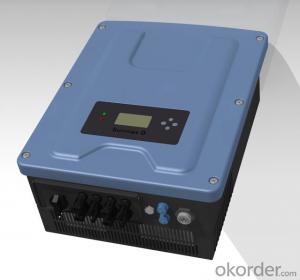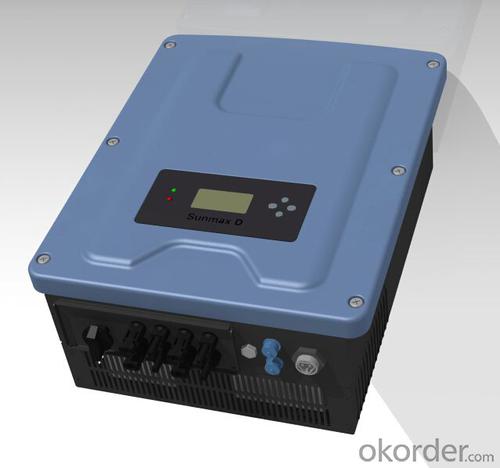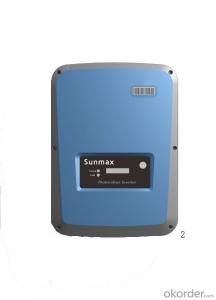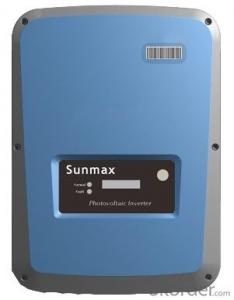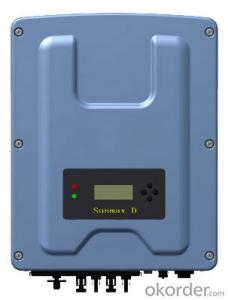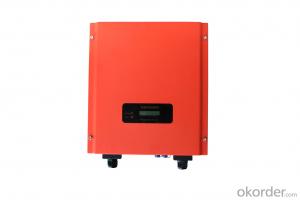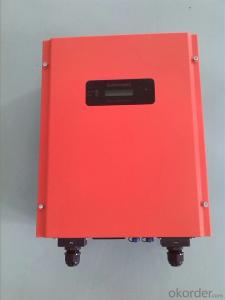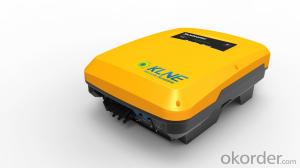Solar Inverter in Nigeria - PV Inverter Sunmax D 3000/4000/5000
- Loading Port:
- Shanghai
- Payment Terms:
- TT OR LC
- Min Order Qty:
- 5 watt
- Supply Capability:
- 3000 watt/month
OKorder Service Pledge
OKorder Financial Service
You Might Also Like
The Sunmax D 3000/4000/5000 series are applicable to rooftop installation and small scale photovoltaic grid-connected power plants. Their rated output powers are 3 kW, 4kW, 5 kW respectively. This series are transformer-less in design and have a wide range of MPPT voltage. Their maximum conversion efficiency and MPPT tracking accuracy reaches 97.6 % and 99.5 % respectively. The maximum DC voltage reaches 580 V. The series have dual MPPT trackers, providing maximum flexibility for solar plants. The series adopts the latest technology, supports reactive power adjustable and meets the VDE-AR-N 4105 standard.
Characteristics:
Dual MPPT with tracking efficiency over 99.9%
Supporting reactive power adjustable
Unit noise less than 30Db
Current harmonic less than 3%
Design features:
Allows access to third party monitoring system: Solar-log, Solar –man, Taoke, etc.
Equipped with active / inactive way to adjust the design instruction
Single / dual MPPT design
IP65 protection class to meet outdoor installation requirements
Transformer-less design
Units have built-in leakage current monitoring devices
Suspension design, installation is simple
Man-machine interface (LCD) in English, Italian, German languages
Man-machine interface (LCD) regulation parameters can be set making installation easy
Total digital design.
- Q: Are there any noise emissions from a solar inverter?
- Yes, solar inverters do produce some noise emissions, although the level of noise is generally very low. The noise is primarily generated by the cooling fans and internal components, but it is usually not significant enough to cause any major disturbances.
- Q: Can a solar inverter be used with different solar panel types?
- Yes, a solar inverter can be used with different types of solar panels. Solar inverters are designed to convert the direct current (DC) generated by solar panels into alternating current (AC) that can be used to power household appliances and feed into the electrical grid. As long as the solar panels produce compatible DC voltage and current levels, they can be connected to the solar inverter. Different solar panel types, such as monocrystalline, polycrystalline, and thin-film, may have varying electrical characteristics, but modern solar inverters are typically equipped with advanced electronics that can adapt to these differences. However, it is important to ensure that the solar inverter is properly matched with the solar panel specifications to ensure optimal performance and efficiency.
- Q: How does a solar inverter handle voltage and frequency variations caused by switching operations?
- A solar inverter handles voltage and frequency variations caused by switching operations through the use of advanced control algorithms and circuitry. It continuously monitors the input voltage and frequency from the solar panels and adjusts its own output voltage and frequency accordingly. This ensures that the power generated by the solar panels is efficiently converted into usable AC power that matches the grid requirements. The inverter's voltage and frequency control mechanisms help maintain a stable and consistent power supply, even in the presence of switching operations or fluctuations in the solar panel output.
- Q: Can a solar inverter be used in countries with different electrical standards?
- Yes, a solar inverter can be used in countries with different electrical standards by ensuring it is compatible with the specific electrical standards of the country. This may involve adjusting the voltage, frequency, and plug type to match the local requirements, or using voltage converters or adapters if necessary. It is important to consult with a professional or check the manufacturer's specifications to ensure proper compatibility and safe operation.
- Q: Can a solar inverter be easily integrated into an existing electrical system?
- Yes, a solar inverter can be easily integrated into an existing electrical system. Solar inverters are designed to seamlessly connect with the existing electrical infrastructure of a building or property. They can be installed alongside the main electrical panel and connected to the grid, allowing the solar energy generated by the panels to be converted into usable electricity for the building's consumption. With the help of a qualified electrician or solar installer, the integration process can be straightforward and efficient.
- Q: What is the PV inverter starting voltage
- Photovoltaic inverter, also known as power regulator, according to the inverter in the use of photovoltaic power generation system can be divided into two kinds of independent power supply and grid. According to the waveform modulation method can be divided into square wave inverter, stepped wave inverter, sine wave inverter and modular three-phase inverter. For the inverter for the grid system, depending on whether the transformer can be divided into transformer-type inverter and transformer-free inverter.
- Q: What is the role of a solar inverter in optimizing energy production?
- The role of a solar inverter in optimizing energy production is to convert the direct current (DC) electricity generated by solar panels into alternating current (AC) electricity that can be used to power homes and businesses. In addition to this basic function, a solar inverter also plays a crucial role in maximizing energy production by efficiently managing the flow of electricity, ensuring that the solar system is operating at its highest capacity, and adapting to changes in sunlight intensity to achieve optimal energy output.
- Q: Can a solar inverter be used in systems with different module strings?
- Yes, a solar inverter can be used in systems with different module strings. Solar inverters are designed to be compatible with a wide range of module string configurations, allowing for flexibility in system design and installation. The inverter's maximum input voltage and power ratings should be considered to ensure compatibility with the different module strings, but as long as these specifications are within the inverter's limits, it can effectively convert the DC power generated by the module strings into AC power for use in the system.
- Q: How does a solar inverter handle voltage unbalance?
- A solar inverter handles voltage unbalance by continuously monitoring the voltage levels of the three phases in the grid. If it detects any imbalance, it adjusts the output voltage accordingly to maintain balance and ensure optimal performance.
- Q: How do you maintain a solar inverter?
- To maintain a solar inverter, regular cleaning of dust and debris is essential to ensure efficient operation. Additionally, monitoring the inverter's performance and checking for any abnormal readings or error messages is important. It is also recommended to inspect the wiring connections for any loose or damaged parts and to keep the inverter's ventilation system clear from obstructions. Regular servicing by a professional technician is recommended to identify and address any potential issues before they become major problems.
Send your message to us
Solar Inverter in Nigeria - PV Inverter Sunmax D 3000/4000/5000
- Loading Port:
- Shanghai
- Payment Terms:
- TT OR LC
- Min Order Qty:
- 5 watt
- Supply Capability:
- 3000 watt/month
OKorder Service Pledge
OKorder Financial Service
Similar products
Hot products
Hot Searches
Related keywords
